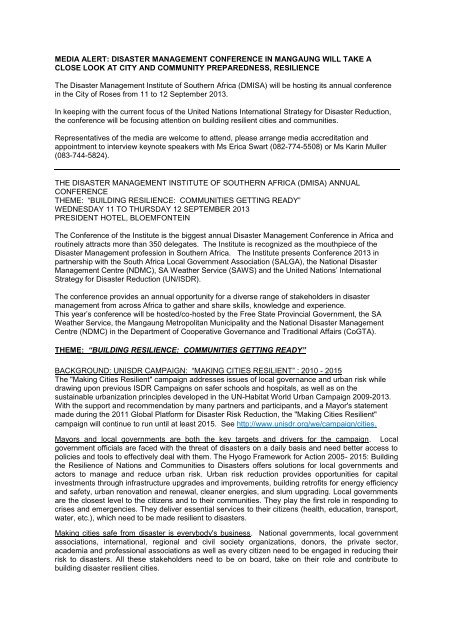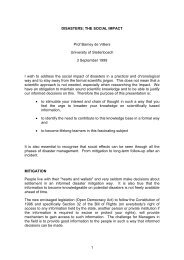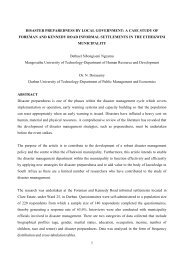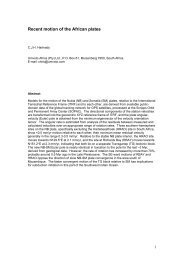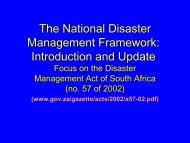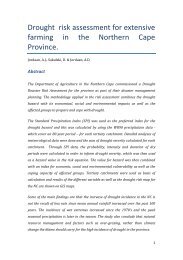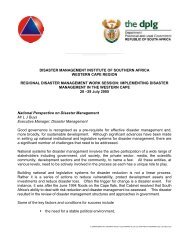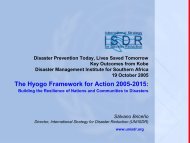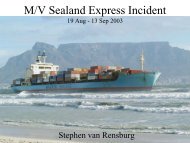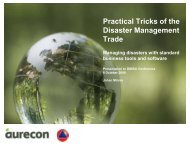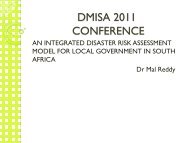MEDIA ALERT - Disaster Management Institute South Africa
MEDIA ALERT - Disaster Management Institute South Africa
MEDIA ALERT - Disaster Management Institute South Africa
You also want an ePaper? Increase the reach of your titles
YUMPU automatically turns print PDFs into web optimized ePapers that Google loves.
<strong>MEDIA</strong> <strong>ALERT</strong>: DISASTER MANAGEMENT CONFERENCE IN MANGAUNG WILL TAKE A<br />
CLOSE LOOK AT CITY AND COMMUNITY PREPAREDNESS, RESILIENCE<br />
The <strong>Disaster</strong> <strong>Management</strong> <strong>Institute</strong> of <strong>South</strong>ern <strong>Africa</strong> (DMISA) will be hosting its annual conference<br />
in the City of Roses from 11 to 12 September 2013.<br />
In keeping with the current focus of the United Nations International Strategy for <strong>Disaster</strong> Reduction,<br />
the conference will be focusing attention on building resilient cities and communities.<br />
Representatives of the media are welcome to attend, please arrange media accreditation and<br />
appointment to interview keynote speakers with Ms Erica Swart (082-774-5508) or Ms Karin Muller<br />
(083-744-5824).<br />
THE DISASTER MANAGEMENT INSTITUTE OF SOUTHERN AFRICA (DMISA) ANNUAL<br />
CONFERENCE<br />
THEME: “BUILDING RESILIENCE: COMMUNITIES GETTING READY”<br />
WEDNESDAY 11 TO THURSDAY 12 SEPTEMBER 2013<br />
PRESIDENT HOTEL, BLOEMFONTEIN<br />
The Conference of the <strong>Institute</strong> is the biggest annual <strong>Disaster</strong> <strong>Management</strong> Conference in <strong>Africa</strong> and<br />
routinely attracts more than 350 delegates. The <strong>Institute</strong> is recognized as the mouthpiece of the<br />
<strong>Disaster</strong> <strong>Management</strong> profession in <strong>South</strong>ern <strong>Africa</strong>. The <strong>Institute</strong> presents Conference 2013 in<br />
partnership with the <strong>South</strong> <strong>Africa</strong> Local Government Association (SALGA), the National <strong>Disaster</strong><br />
<strong>Management</strong> Centre (NDMC), SA Weather Service (SAWS) and the United Nations’ International<br />
Strategy for <strong>Disaster</strong> Reduction (UN/ISDR).<br />
The conference provides an annual opportunity for a diverse range of stakeholders in disaster<br />
management from across <strong>Africa</strong> to gather and share skills, knowledge and experience.<br />
This year’s conference will be hosted/co-hosted by the Free State Provincial Government, the SA<br />
Weather Service, the Mangaung Metropolitan Municipality and the National <strong>Disaster</strong> <strong>Management</strong><br />
Centre (NDMC) in the Department of Cooperative Governance and Traditional Affairs (CoGTA).<br />
THEME: “BUILDING RESILIENCE: COMMUNITIES GETTING READY”<br />
BACKGROUND: UNISDR CAMPAIGN: “MAKING CITIES RESILIENT” : 2010 - 2015<br />
The "Making Cities Resilient" campaign addresses issues of local governance and urban risk while<br />
drawing upon previous ISDR Campaigns on safer schools and hospitals, as well as on the<br />
sustainable urbanization principles developed in the UN-Habitat World Urban Campaign 2009-2013.<br />
With the support and recommendation by many partners and participants, and a Mayor's statement<br />
made during the 2011 Global Platform for <strong>Disaster</strong> Risk Reduction, the "Making Cities Resilient"<br />
campaign will continue to run until at least 2015. See http://www.unisdr.org/we/campaign/cities.<br />
Mayors and local governments are both the key targets and drivers for the campaign. Local<br />
government officials are faced with the threat of disasters on a daily basis and need better access to<br />
policies and tools to effectively deal with them. The Hyogo Framework for Action 2005- 2015: Building<br />
the Resilience of Nations and Communities to <strong>Disaster</strong>s offers solutions for local governments and<br />
actors to manage and reduce urban risk. Urban risk reduction provides opportunities for capital<br />
investments through infrastructure upgrades and improvements, building retrofits for energy efficiency<br />
and safety, urban renovation and renewal, cleaner energies, and slum upgrading. Local governments<br />
are the closest level to the citizens and to their communities. They play the first role in responding to<br />
crises and emergencies. They deliver essential services to their citizens (health, education, transport,<br />
water, etc.), which need to be made resilient to disasters.<br />
Making cities safe from disaster is everybody's business. National governments, local government<br />
associations, international, regional and civil society organizations, donors, the private sector,<br />
academia and professional associations as well as every citizen need to be engaged in reducing their<br />
risk to disasters. All these stakeholders need to be on board, take on their role and contribute to<br />
building disaster resilient cities.
The <strong>South</strong> <strong>Africa</strong>n National <strong>Disaster</strong> <strong>Management</strong> Centre has introduced Phase 2 of the International<br />
Strategy for <strong>Disaster</strong> Reduction Campaign theme for 2010-2015: “Making Cities (Municipalities)<br />
Resilient: My City (Municipality) Is Getting Ready” (to implement DRR) at the DMISA Conference<br />
2012. The campaign strategy is that it should aim at creating an enabling environment of risk<br />
reduction at local level through the following strategic approaches:<br />
<br />
<br />
<br />
Political dimension: to attain commitments at local and national level to reduce disaster risk in<br />
a sustainable way by increasing investments within existing development programmes and<br />
budgets.<br />
Technical dimension: to facilitate the implementation of disaster risk reduction measures in<br />
municipal planning and implementation (i.e. through IDPs, compliance with building codes,<br />
etc).<br />
Communications/Advocacy dimension: to enhance awareness about disaster risk among<br />
different stakeholders, including local leaders, communities and other role players.<br />
The Campaign Partners and Target Audience:<br />
Primary audience:<br />
• Municipal structures: A Municipal planning process should be participatory, allowing all<br />
stakeholders to consider how best to integrate disaster risk reduction elements and the ‘ten<br />
essentials’ into their development plans and activities.<br />
(http://www.unisdr.org/campaign/resilientcities/toolkit/essentials)<br />
• Communities, civil society formations, Non-Governmental Organizations/Community Based<br />
Organizations, Faith Based Organizations can play a major role through “community action<br />
planning”. The importance of participative, community-based approaches is generally<br />
acknowledged in the fields of development, disaster preparedness, mitigation, response and<br />
recovery measures.<br />
Secondary audience:<br />
• National and provincial government:<br />
o<br />
o<br />
o<br />
To develop appropriate policies and legislative frameworks.<br />
To build adequate capacity and allocate resources.<br />
To involve non-state actors to support implementation.<br />
• Academic institutions:<br />
o<br />
o<br />
o<br />
o<br />
To design and implement DRM/R education and training programmes.<br />
Awareness creation on DRM/R issues.<br />
Development and roll-out of advocacy, awareness and research programmes.<br />
Knowledge management and advisory services (i.e. information and advisory services).<br />
• DRM professional bodies such as DMISA<br />
PROGRAMME HIGHLIGHTS<br />
OPENING CEREMON Y<br />
Candle ceremony and moment of silent reflection<br />
DR MAL REDDY: PRESIDENT: DMISA
Welcome<br />
WMS S M MLAMLELI<br />
MEC: CoGTAHS, FREE STATE<br />
KEYNOTE ADDRESS AND OFFICIAL OPENING<br />
THE HONOURABLE MINISTER S L TSENOLI :MINISTER OF COOPERATIVE GOVERNANCE AND<br />
TRADITIONAL AFFAIRS<br />
WATCHING THE WEATHER TO PROTECT LIFE AND PROPERTY<br />
MR MNIKELI NDABAMBI, SOUTH AFRICAN WEATHER SERVICE<br />
DROUGHT INSURANCE FOR EXTENSIVE LIVESTOCK FARMERS BASED ON<br />
STANDARD PRECIPITATION INDEX AS A TOOL FOR DROUGHT RISK REDUCTION<br />
DR ANDRIES JORDAAN, DiMTEC, UNIVERSITY OF THE FREE STATE<br />
SEVERE CONVECTIVE STORM RISK IN SOUTH AFRICA: CHALLENGES AND UNCERTAINTIES IN<br />
BUILDING THE RESILIENCE OF VULNERABLE COMMUNITIES<br />
DR DESMOND PYLE, STENDEN UNIVERSITY, PORT ALFRED<br />
THE USE OF WARD COMMITTEE WORKING GROUPS IN MAKING COMMUNITIES MORE<br />
RESILIENT<br />
MR HENK LOMBARD, DISASTER MANAGEMENT CENTRE: PHALABORWA<br />
INFORMAL SETTLERS DOLOMITE SINKHOLE RISK AWARENESS, ZONKIZIZWE EXTENTION SIX,<br />
SOUTH AFRICA<br />
MR JOHANES BELLE, DiMTEC, UNIVERSITY OF THE FREE STATE<br />
AN IMPLEMENTATION TOOL GONE OFF THE RAILS: COUNTING THE COSTS OF A LEVEL 3<br />
DISASTER MANAGEMENT PLAN<br />
DR JOHAN MINNIE, AURECON<br />
EVIDENCE BASED FIRE PREVENTION PROGRAMME TARGETING HIGH RISK COMMUNITIES<br />
MR RODNEY EKSTEEN, PROVINCIAL DISASTER MANAGEMENT CENTRE: WESTERN CAPE<br />
<strong>MEDIA</strong> COVERAGE AND DISASTER OCCURRENCE IN KWA-ZULU NATAL (KZN) PROVINCE: AN<br />
EMPIRICAL ANALYSIS<br />
DR BETHUEL NGCAMU, UNIVERSITY OF KWA-ZULU NATAL<br />
INCIDENT MANAGEMENT: ARE YOU AND YOUR COMMUNITY PREPARED FOR ALL POTENTIAL<br />
MINOR AND MAJOR INCIDENTS<br />
M S FRANCIS HOETS, DISASTER MANAGEMENT SOLUTIONS (DMS)<br />
A NATIONAL DISASTER MANAGEMENT PERSPECTIVE ON PROGRESS IN SOUTH AFRICA<br />
MR KEN TERRY, HEAD: NATIONAL DISASTER MANAGEMENT CENTRE (NDMC)<br />
COMMUNITY RESILIENCE THROUGH FOOD SECURITY<br />
MR FERDI MOCKE, DISASTER MANAGEMENT SOLUTIONS (DMS )<br />
AFTER THE RISK MAPPING WHAT NOW<br />
MR MALCOLM PROCTER, DEPARTMENT OF AGRICULTURE, FORESTRY AND FISHERIES (DAFF),<br />
FREE STATE<br />
COMMUNITY-BASED FIRE RISK REDUCTION AT KHAYELISHA INFORMAL SETTLEMENT,<br />
GRASSLAND PHASE 4 OF MANGAUNG METROPOLITAN MUNICIPALITY<br />
MS LIZZY MORAKE, PROVINCIAL DISASTER MANAGEMENT CENTRE: FREE STATE<br />
HOW READY ARE WE FOR HAZMAT INCIDENTS<br />
MR THINUS RABE, KIMBERLEY MICRODIAMOND LABORATORY: DE BEERS EXPLORATION<br />
BUILDING RESILIENCE THROUGH TRAINING AND DEVELOPMENT IN COMMUNITIES<br />
MS JOZELLE STEENKAMP, CHILDHOOD CANCER FOUNDATION SA<br />
MAKING CITIES RESILIENT CAMPAIGN – MY CITY IS GETTING READY
MS CHARLOTTE POWELL, DISASTER RISK MANAGEMENT CENTRE, CITY OF CAPE TOWN<br />
DISASTER MANAGEMENT: A LINK TO EFFECTIVE INFRASTRUCTURE MANAGEMENT<br />
MS MANDISA NOHASHE, DISASTER MANAGEMENT CENTRE: CACADU DISTRICT MUNICIPALITY<br />
ASSESSING THE KNOWLEDGE, ATTITUDES AND PRACTICES REGARDING CHOLERA<br />
PREPAREDNESS AND PREVENTION IN MAMPURU VILLAGE, LIMPOPO, SOUTH AFRICA<br />
MS ALICE NCUBE, DiMTEC, UNIVERSITY OF THE FREE STATE<br />
THE USE OF VULNERABILITY MAPPING IN BUILDING COMMUNITY RESILIENCE<br />
DR HERMAN BOOYSEN, AURECON<br />
THE SEVERE WEATHER WARNING SERVICE OF SOUTH AFRICA: DEVELOPMENTS TO IMPROVE<br />
SERVICES TO DISASTER MANAGEMENT<br />
MESSRS EUGENE POOLMAN AND HUGH VAN NIEKERK , SOUTH AFRICAN WEATHER SERVICE<br />
TOWARDS A NATIONAL INCIDENT COMMAND SYSTEM FOR DISASTER MANAGEMEN T<br />
MR COLIN DEINER, PROVINCIAL GOVERNMENT: WESTERN CAPE<br />
DEVELOPMENT OF A DISASTER MANAGEMENT ORGANISATIONAL FRAMEWORK FOR<br />
OCCUPATIONS (OFO) QUALIFICATION CODES<br />
MR ANTHONY KESTEN, DMISA COUNCILLOR<br />
Issued by:<br />
The <strong>Disaster</strong> <strong>Management</strong> <strong>Institute</strong> of <strong>South</strong>ern <strong>Africa</strong> (DMISA)<br />
123 Rietfontein Rd<br />
PO Box 7130<br />
Primrose Hill<br />
1417<br />
<strong>South</strong> <strong>Africa</strong><br />
www.disaster.co.za<br />
Contact: Dr Maliga Reddy (President), Tel 083-262-7796<br />
Dr Johan Minnie (Deputy President), Tel 084-220-0074<br />
Ms Erika Swart (Conference Coordinator), Tel 082-774-5508<br />
Ms Karin Muller (Administrator) Tel 083-744-5824


